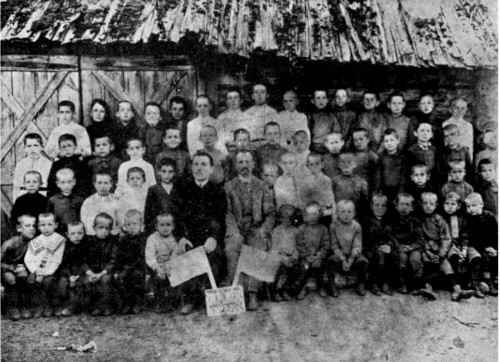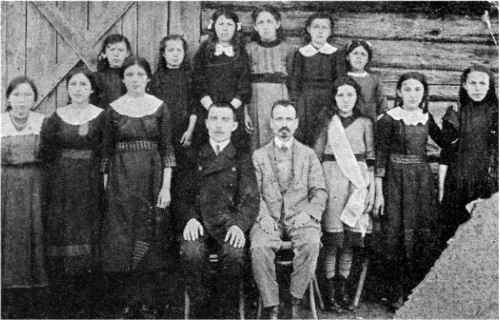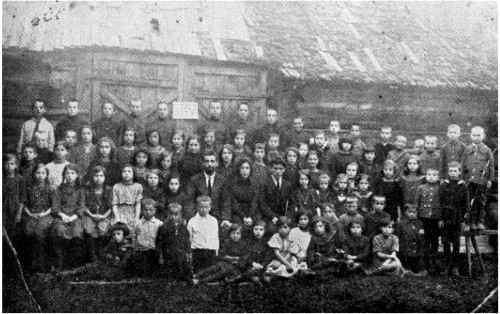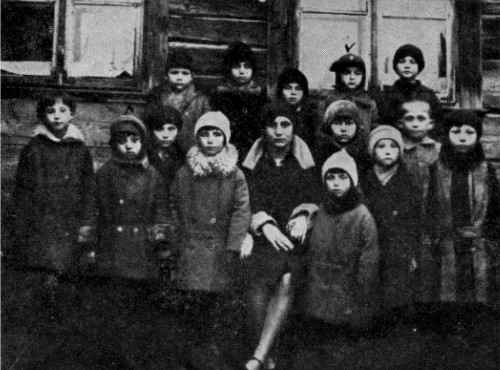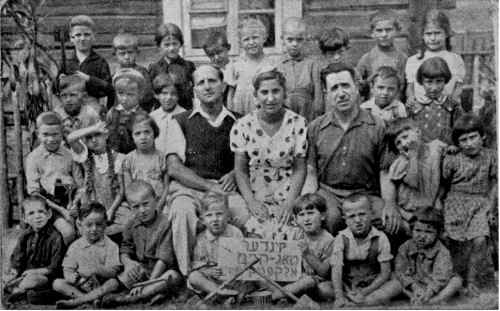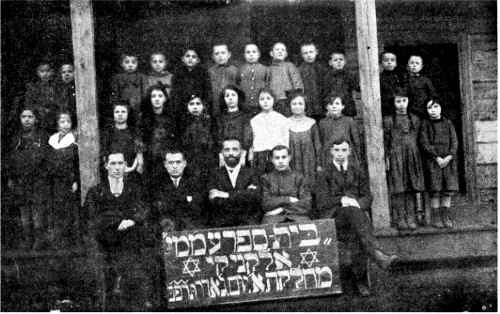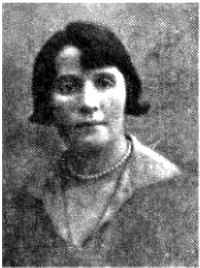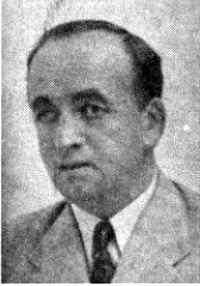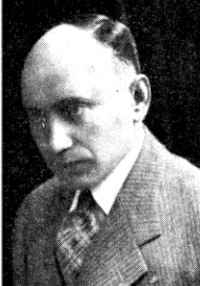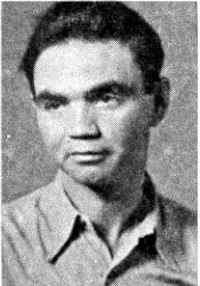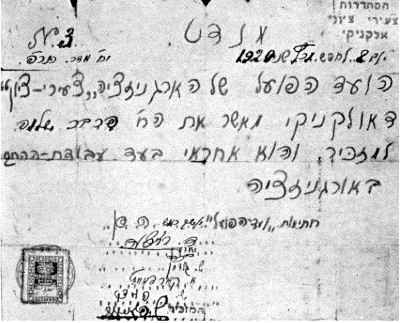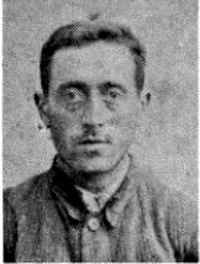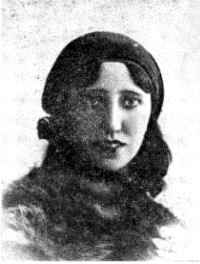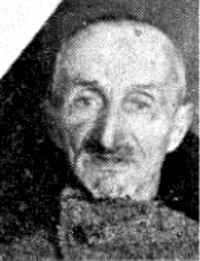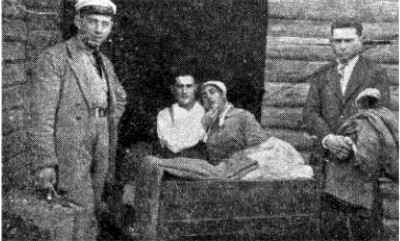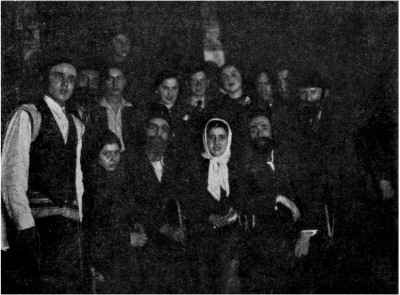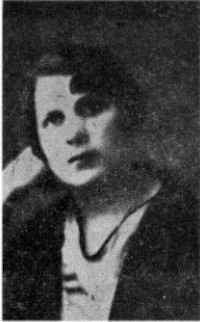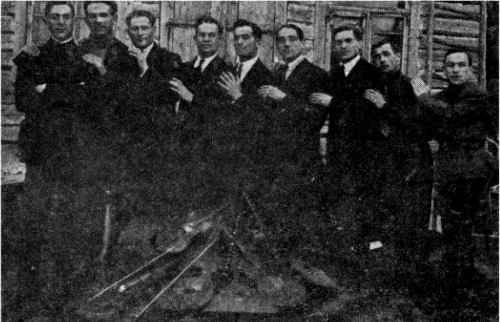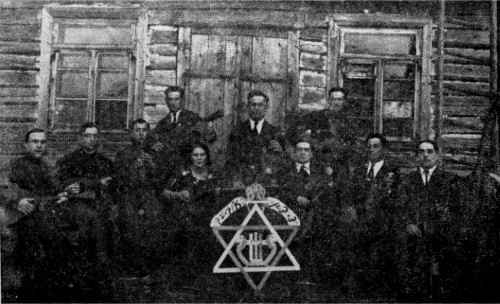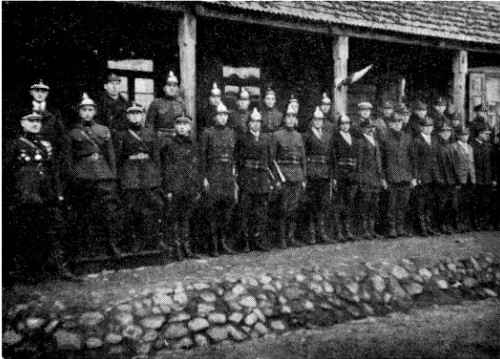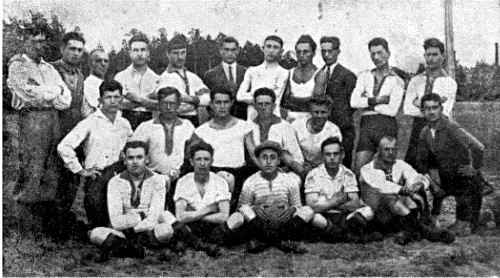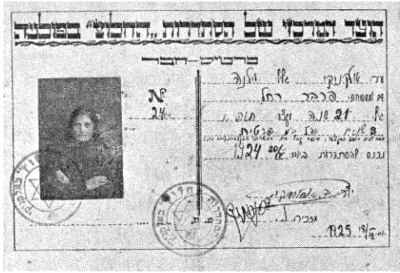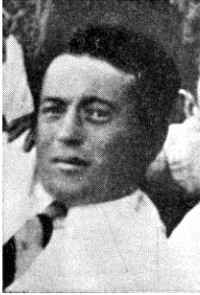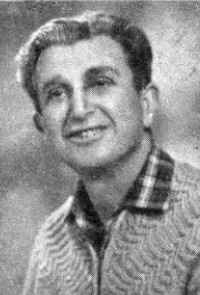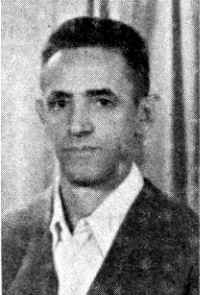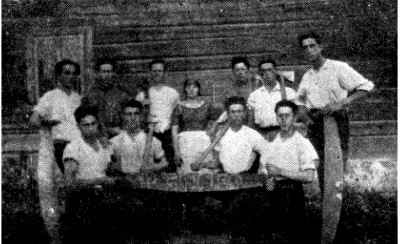[Page 21]
Olkeniki From the Beginning
of the Century Until the Holocaust
Translated by Mira Eckhaus
Edited by Erica S. Goldman-Brodie
| Olkeniki, was a town in the Vilna community, Vilna-Truki district, on the Marchenka River, a train station. 50 km southwest of Vilna, paper factory, leather factory, flour mill, 680 residents. District Officer Seat on 1921. Olkeniki housed a royal palace by the lake created by the Marchenka River, which was regularly visited by the two Sigmunds in the 16th-century. |
| (“Altima General Encyclopedia”) |
The twentieth century found the town stagnant and living its normal life. The great shocks in the life of the Russian kingdom did not change the course of its life and its affairs. The young men that were recruited into the Tsar's army, tried in all sorts of ways to dodge the army.The ruler of the town was, as usual, the policeman - Strazhnik, and the emblem of the policeman – the “Oriadnik”.
The news from the big and emerging world in Greater Russia reached the town by a few newspapers, including “The Time” and Russian newspapers. A group of educated people, amongst whom were scholars of the Beit Midrash, brought some general education to the town. They began teaching reading and writing in Russian in addition to the studies at the Cheders. Among the “teachers” were Ephraim Dragozhansky, who also wrote court applications, Radowski, Shemaiah and others.
The buds of Zionism
It is difficult to determine exactly when and how Zionism penetrated the town.If we consider it according to the “East” on the walls of houses, according to the pictures of the Western Wall and the Meah She'arim Yeshiva, the “receipts” of the charitable institutions in the country, which elders would collect to share with their spouses after “a hundred years” and take them to the grave;Or if we count the bags of yellow Land of Israel that were kept in the “genizah” of the family members, then it was possible to safely indicate the inner mental connection of previous generations to the Land of Israel and everything in it.
I have a share certificate of the “Treasury of the Jewish Settlement” bought by Reb Yosef Deborzen, from Olkeniki, in 1900 with the signature of A. Katzenelnboigen. Apparently, he purchased it on the travels he made due to his involvement in the timber trade. At the beginning of the century, Reb Shlomo Monash Goldman, an old tinsmith, immigrated to Israel from Olkeniki with his wife. After him, in 1911, Reb Velvel-Ze'ev Braz and his family immigrated to Israel and settled in Petah Tikva. In 1913, Reb Zvi Polyachek, may God avenge him, from Olkeniki, visited Eretz Israel.
Institutions, organizations and public life
The establishment of the library
A library of holy books has existed in the town for a long time, from the period of the “Kollels” whose teachers taught in the Beit Midrash in the nineteenth century and from the period of the last generation of Yeshiva members and the Beit Midrash scholars in the town. The warehouses of the “names” and the book fragments that filled special rooms and boxes under the stages in the Beit Midrash and the old synagogue are evidence of this. In a later period, the “names” multiplied to such an extent that it was necessary to transfer them in a “funeral” to the cemetery for burial.
In 1908, a popular library was founded by a group of educated people, including Shmuel Eizikov, Ben-Zion Meltzman, Alter Poplak, Oshiathe Krienkai and others, which had books in Yiddish, Hebrew and Russian.The library was open to all and its staff worked voluntarily. From year to year the number of books that enriched the spirit of the youth, that was eager for knowledge, increased. Also, the ultra-Orthodox and scholars of the Beit Midrash would secretly read modern Hebrew literature and Yiddish literature During the years of the First War and the German occupation, the library was destroyed and most of its books were rolled in boxes and private people's houses. Only in 1918, was the library renewed by the Zionist youth; New books were bought, the old ones were repaired, and with the help of “Yakafa” company, its operation was renewed.
With the departure of young people to Eretz Israel and the big cities to study Torah and enrich their knowledge, and due to the unrest and controversy that increased among the youth on the Jewish Street, the library was closed for several years. It was not until 1927 that it was reopened by the people of the town who were close to “Wilbig” (vilnerbildung-gezelshaft). That year, there were in the library books for adults and youth as follows: 530 books in the Hebrew language, 560 in Yiddish and
[Page 22]
150 in Russian. The library's last librarian was the teacher Benjamin Farber, who was appointed librarian by the local authority. As one of the cultural figures of the town he was taken first with other four members of the town by the Nazi oppressors to the Vilna prison and Paneriai, may God avenge him. (On the last days of the library see below).
The foundation of the Hebrew school “Tchia”
In 1912 (5672), a modern Hebrew school was founded in town. The founders were educated townspeople: grocers, merchants and artisans who wanted to provide their children with general education.
The teachers at the school learned “Hebrew in Hebrew”. Teacher Friend came to us from a distant city, from Bryansk, in central Russia and brought with him his brother as well. He was a quiet and gentle guy and his influence on us was multi-faceted. He also knew astronomy. I remember that on the window sill of his room was hung a thread and its shadow indicated the alternation of the hours of the day. (As I was told, Mr. Friend is now in the United States, where he is the editor of an astronomy newspaper). A year later he disappeared, and was replaced by the teacher Zaslansky, a student of the Grodno courses. During the summer, another teacher named Kulik came, who tried to teach us painting, he succeeded in doing so only partially. The Russian teacher was the local teacher, Radowski, who taught most of the townspeople before the school was founded and even after it closed. In the school there were about a hundred students in all the classes. Students from nearby towns and villages also came to study at this school.
|
|
Tchia School in 5672, 1912
Top row, (right), David Zelikowicz (Canada), Gans, L.Malifon, I. Schneider from Eishyshok(Israel). A. Menachemi (Israel),H. Rabinowitz (Mexico), Noah Zelikowicz (Canada), Zamodsky Mamerch, Pocharnik from Dakshaniya, H. Deborzen (USA), A. Tzofnat from Dakshaniya, Freund from Bryansk, S. Polchek (Israel). B. Diner (USA). S. Kadesh
Second row: Ratzer, Y. Azhransky-Agami, Goldberg, I. Dan, Nathan Pickleny, L. Maltzman (Israel), A. Nanes (Mexico), S.Farber, M.Mizrotsky (Israel), S. Bozgan, A. Beklarisky, Arie Kaplan (Australia), I. Karpowitz (Israel), S. Ferewletsky, Shmuel Katz
Third row: (right) Shimanovich, N. Menachimovich-Menachemi, M. Menachimovich-Menachemi (Israel), Balan, H. Garesh, G. Melzman, H. Goldberg, Levy, M. Fine, DovAzransky-Agami, (Israel), B.Menachemi (died in Israel)
Fourth row: T. Zubiski, S. Dan (Israel), Pinon, S. Karpowitz (Israel), Korkodiansky (USA), Levin, I. Hariztel (Israel), Nanes, Fine, Levin, M. Bichwid, A. Telez (Israel), M. Orliansky, Pinon |
[Page 23]
Educational institutions in the town
|
|
Private school of the teachers Radowski and Freund in 1912
Top row: M. Bank, Z. Zubiski, H. Kadesh, Babka Taibs, Y. Burstein, A. B. Radowski
Second row: A. Radowski, L. Fine, M. Nanes, M. Ridlitsky, A. Fine, H. Zandman |
|
|
| “Tarbut” Hebrew School in 5682, 1922 |
[Page 24]
|
|
A daycare center for children in the years 1939-40
Teachers: Unkeles, M. Polak, B. Farber |
[Page 25]
|
|
“Tarbut” elementary school in 5682-1922
A. Korkodiansky. Teachers: Shapira, Z. Senznik, Berkman, Shifman |
|
|
| Teacher Gita Markovna Sachs |
The transformations of Tchia School
With the outbreak of World War I, in 1914, the school was closed, and everything in it was destroyed. Students returned to studies in the Cheders that continued to exist, or traveled to Yeshivas in adjacent towns.
With the arrival of the Germans and “their culture”, in 1915, a school was opened with classes in German. Only in 1918-1920 was a modern school was reopened. The teachers were students of the pedagogical courses in Vilna that was founded by the “Yakafa” company: Berkman, Shapira, Shifman and the local teacher Reb Zvi Senznik.
This school, too, has undergone various transformations due to the wars and quarrels regarding education, religion and tradition. “Tarbut” school operated for a long period and the teachers who taught there were Petuchovsky, Ripper,Dov Chomsky (now in Israel) and others. Upon its closure, a religious school “Horev” was established in its place. In 1930, about 60 children attended this school in 5 classes, and it had 3 teachers. In the 1930s, there was also a small Yeshiva in the town where about 20 young people studied. The girls studied at the Polish elementary school, which was located on the edge of town. Most of the adolescent youth, who aspired to study, left the town and went to the city of Vilna to study in seminars and gymnasiums, and the rest dispersed in Yeshivot.
[Page 26]
World War I
brought a deep shock to town life. Many young boys who worked in the army were sent to the battlefront and some of them did not return home. Family members were also displaced from their homes and sent to the battlefront. The Russians recruited and took all the horses of the peddlers and merchants. Some of the warriors were captured by the Germans and stayed there for several years.
The town's large factory, which included a sawmill, a flour mill and a crusher, was bombed by the retreating Russians. The factory at the other end of town, on the Soltza River, that was used for the cardboard industry, was also partially bombed by the Russians. The breadwinners were taken to the army and the town sank into poverty and destitution.
The German occupation
The period of German occupation in the years 1915-1916 brought destruction to the life of the town. The livelihoods of the Jews were completely destroyed. The Germans took over the town's meager natural resources, confiscated the animals and produce that the farmers brought to town. The youth, as well as married men, were sent to forced labor in the sawmills of Augustova, and for road paving in other places.The sacks and blankets became fabrics from which clothes were sewn. Rubber straps were used as soles for shoes. They mostly used wooden clogs of all shapes. Hunger and distress caused the sacred family morality of generations to decline at the edges of society as well. The property of the townspeople was transferred to the village. In exchange for a plate of rye, or a sack of potatoes, the townspeople handed over their jewelry and household utensils. Groups of teenagers carried on their shoulders for a distance of tens of kilometers away sacks of grain to save their parents' life. When the Germans left the town, they left behind destruction and ruin. The only thing they did during their stay in town was to build a road of wooden beams that led to the train station to Vilna, which rotted a few years later.
The Balfour Declaration
The declaration lit up our lives like lightning on a dark night. It gave hope and excited the youth of the town. All the discussions and negotiations that preceded the declaration were not known in the town. They did not ask or demand it, the content and the main thing were clear: from now on we have a place in the world, where we can be. I remember the parade with the Torah scrolls under the canopy and the flags of the nation at its head, and the festive occasion when all the people of the town, including the Christians, gathered at the courtyard in front of the old synagogue. After the opening of the pharmacist Sternin, the words of the local rabbi, the speeches of the brothers Isaiah and Hillel Dan, I spoke about the vision of the dry bones.
Since then, extensive cultural and educational action has begun among the youth strata in the town. There was hardly a young boy or a girl left who was indifferent to our enthusiasm and activity.The shoemakers,the seamstresses, the tailors, blacksmithsand the unemployed - all made their contribution by raising funds for the movement's funds, for the library and for local cultural activities.
Committee Members of the Youth of Zion (Tze'irei Zion) in 1920
|
|
|
|
|
|
Simcha Foltchek,
Committee member |
|
Shlomo Farber,
Secretary |
|
Hillel Dan,
Chairman |
[Page 27]
In 1917, the Youth of Zion (“Tze'irei Zion”) Association was founded. The youth, scholars of the Beit Midrash, sons of merchants, grocers and workers joined the association. Among the founders were Yitzhak Burstein, the brothers Hillel and Yehoshua Dan, A. Korkodinsky, Shlomo Farber, Sarah Goldman, the Kot sisters and others. The association was connected to the center of Vilna and Warsaw. The first chairman of the association was Hillel Dan (a former manager of “Solel Boneh”). I served as secretary. That year, I attended a conference of the district of Vilna. We met frequently with the power of attorneys of the center who encouraged our operation in the town.
|
|
| Approval of the Histadrut “Tze'irei Zion” from 1920 |
Amateur bands
The buds of amateur theater grew as early as 1904, when Alter Meltzman, the barber,stepped on stage in the play “David and Goliath” and read: “klaybtaoys fun aich dem gresten held aunzol er aroystsu mir aoyfnfeld”. (“Choose from among you the largest hero and send him to me in the field.”) But in our time, between two world wars, the repertoire was already different, the halls were different and the actors were at a high level, sometimes very high. Until the 1920s, the team consisted of Sarah Goldman, the Rabin brothers, Leib Karpowitz, B.Z. Willin and others. In the following years, excellent actors were added from among the young people, including Rivka Farber, Sheyna Bozgan, Beila Radowski, Michael Pollak, and finally the elders in the group - Lazar Warman and Leib Kopens– joined and also from the young actors Zalotsky, Valofiansky and others. The venue of the plays varied according to the possibilities and the season; they played in the old barracks, in the ruined Russian Christian church, in grain warehouses and so on.
The repertoire was from the best literature in Yiddish.Among the amateurs were those who deserved to perform on an artistic stage. The songs and excerpts from the plays were sung and recited in the town houses for months, until a second play was already on the agenda.All the townspeople, from big to small, except the most orthodox, came to see the play. A lot of young people would come in carts and trains from the nearby towns because the reputation of the amateur band spread all around.
[Page 28]
|
|
|
|
|
|
Michael Pollak,
may God avenge him,
played until the Holocaust |
|
Rivka Farber-Frinkle,
played from 1923-1932 |
|
Alter Meltzman–
from the actors of 1905 |
|
|
The comic play
N. Karpas, A. Meltzman, L. Rabin, P. Meltzman |
|
|
| The “Slaughter” (HaShchita), the last play in 1939 |
[Page 29]
The orchestra
There were minstrels in the town, who were singing and playing at weddings. However, the center of the orchestra was Yitzhak Yosef (Itze Yashke) Chaya Rachel's (Crook). His father was a locksmith in a nearby factory, a humble Jew, and his mother was known for her agility and alertness.
While he was a child, he actually built a small violin by himself and played it. Then he learned the locksmith work and in his spare time played the Violin. His two sisters and a few other musicians formed a 12- “instruments” orchestra. His brother Moshe was one of the first to go to Vilna to attend a professional school. In joys (simchas) and balls, they were the center of attention because their playing was pleasant and graceful. Some of them later made playing a profession in which they were engaged and would travel to play at weddings in the nearby towns and even came to the courtyards of the Polish landowners (Paritzim). For a time, a special orchestra of mandolin and balalaikas played alongside the orchestra.
|
|
|
|
| Hinda Crook, may God avenge her |
|
The String Orchestra in 1920
M. Tzipin, A. Meltzman, B. Willin, J. Willin, A. Karpowitz, Joseph Crook, L. Rabin, B.Z. Margolin |
|
|
| The Youth of Zion Mandolin Orchestra in 1921 |
[Page 30]
The Firefighters' Volunteers
Since the town houses were wooden houses and the fires constantly attacked the town, the insurance companies, which were interested in reducing the damage, donated sums of money to buy extinguishing machine from donations from the government and local fundraisers, they built a hut in the center of the market and housed the extinguishing machine and other fire extinguishers there. The first commander was Alter Ashils, the barber. The command was passed on to his son and finally, when young peasants joined the volunteers' company, the command passed to a Jewish officer who owned a liquor store.
|
|
The firefighters
On the left, Commander Kirschenbaum and his deputy, Gad Meltzman |
Football team
In those years, a football team of Jewish youth and local Christians organized games with teams from nearby towns. The amateur players devoted their free time to training. The competitions were held on Saturdays, or Sundays of the week on the sports field, in the woods, on the way to the factory. A few of the players were privileged to immigrate to Israel.
|
|
| A football team from the townspeople |
[Page 31]
The first pioneers (Chalutzim)
During the wars and riots between the Polish occupiers of Vilna and the Lithuanians in 1920, the first group among “Youth of Zion” was formed and with no means, on foot, evaded and moved to Lithuania on the way to Eretz Israel. This group included Hillel Dan, Yehoshua Dan, Yaakov Azhiransky (Agami), Avraham Menachemi (Ein Harod). After a while Dov Agami (Ein Harod) moved to Lithuania. In 1924, a second group of pioneers was organized, including Haim and Tzipora Zubiski, the Menachemi family, Yosef Karpovitz, Ita Beila Radowski, Piklani, Arie Meltzman Butrimovich and others.
In a later period, the “Chalutz” movement was founded and afterwards the “Chalutz Tzair”, and with each wave of pioneers and immigrants who immigrated to Israel, also went people from the town. Until the Holocaust, there were about 60 people in Israel from the Olkeniki community. After the Holocaust, about 15 people immigrated to Israel, including bunker survivors, partisans and Red Army fighters.
|
|
| The Chalutz's membership card |
From the first of the third and fourth Aliyah
|
|
|
|
|
|
| Nathan Pickelny, may God avenge him |
|
Yaakov Agami |
|
Avraham Menachemi |
|
|
| A group of pioneers in training in the town |
[Page 32]
Paths
by Avraham Menachemi
Translated by Mira Eckhaus
Paths preceded me even before I came out of my mother's womb,
They leveled a road for me even before I knew how to walk:
Bend down, diminish your importance, lower your look and wonder,
and be afraid of everyone who walks upright, or has shining buttons.
In the room there is a gloomy old man, his eyes are tired, radiating terror.
Children are squealing loudly, and his lips are cursing.
His right hand holds a whip, and with his left hand he orders me:
to memorize Shir HaMa'alo for the new born,[1] and the Yizkor prayer for the dead.
In the Beit Midrash, full of gloomy shadows,
people are dressed in black, with pale faces and isolated in corners,
and at dusk, a morose curling voice is heard:
An innocent child calls out “Eli, Eli (my God, my God);”
and from a spiritual treasure comes a decisive voice
directing him to take a candle, be alone, and pray.
And the shadow will last you for long days.
And I will wind my way through the dark paths of exile.
When I dodge the dark alley of my gloomy life,
to reach the green, sunny fields filled with birdsong,
flocks of sheep and cattle,
people plowing the fields and singing of the reapers,[2]
an abundance of light falls upon me,
and the life of a meager exile is revealed to my eyes.
And on a market day, while the square was full of people, poultry, and beasts,
and the bounty of the field, a glory to the man who creates,
I saw my people in their poverty, withering,
handing them their only plow instead of money
To get in return some of the yield of a foreign land.
And the next day, there is also
the trade on their bodies and souls without any reward.
And I am being fed by a jealousy,
the jealousy of a nomad for a healthy people connected to the land.
While I was still young, about 18 years old,
a bright light illuminated the darkness of my path;
I heard the pioneer call: Rise up, young man of the people of Israel!
Straighten up, break the chains of exile, stand up and be redeemed!
The paths of the past burned beneath me,
the paths wavered, the cables broke, and I shook myself free.
I grew the wings of freedom and traveled great distances,
wheels screeched, waves roared, sirens whistled,
and the sun rose for me on the shores of the land of the ancestors.
A new song of life, the mountains rolled in their echoes:
The sound of the beating hammers, the blast of rocks, and the noise of the horsemen of the guards,
the destroy of the reeds and the fevered nests, and the herds of the conquerors of the wilderness;
The joy of those who plow in the fields and the prayer of those who sow.[3]
And in streams of sweat, in mud and in a raging fever,
A forged body, and a radiant and purified soul are formed.
The sun heats in the quarry of the mountain slopes above the camp of the tents,
I spread my bandaged palms, the tuition paid for the redemption of the Land of Israel
and I bless with a Shacharit prayer (morning prayer) the dwellings of the pioneers
with a pure prayer:
How good are your tents, Jacob, your dwellings, Israel![4] |
Translator's footnotes
- This prayer, which is based upon Psalm 121, is known in English as the “Song of The Pilgrims,” those who “ascend” to the Land of Israel. According to Jewish mystical tradition, this prayer is recited at the time of childbirth to ask for Divine mercy for an easy delivery. Return
- These words draw upon Psalm 126:5, which says that those who sow in tears shall reap with songs of joy. Return
- As noted above, these words draw upon Psalm 126:5. Return
- The Blessing of Bala'am, Book of Numbers / Bamidbar 24:5. Return
This material is made available by JewishGen, Inc.
and the Yizkor Book Project for the purpose of
fulfilling our
mission of disseminating information about the Holocaust and
destroyed Jewish communities.
This material may not be copied,
sold or bartered without JewishGen, Inc.'s permission. Rights may be
reserved by the copyright holder.
JewishGen, Inc. makes no representations regarding the accuracy of
the translation. The reader may wish to refer to the original material
for verification.
JewishGen is not responsible for inaccuracies or omissions in the original work and cannot rewrite or edit the text to correct inaccuracies and/or omissions.
Our mission is to produce a translation of the original work and we cannot verify the accuracy of statements or alter facts cited.
 Valkininkai, Lithuania
Valkininkai, Lithuania
 Yizkor Book Project
Yizkor Book Project
 JewishGen Home Page
JewishGen Home Page
Yizkor Book Director, Lance Ackerfeld
This web page created by Jason Hallgarten
Copyright © 1999-2025 by JewishGen, Inc.
Updated 6 Oct 2024 by LA
